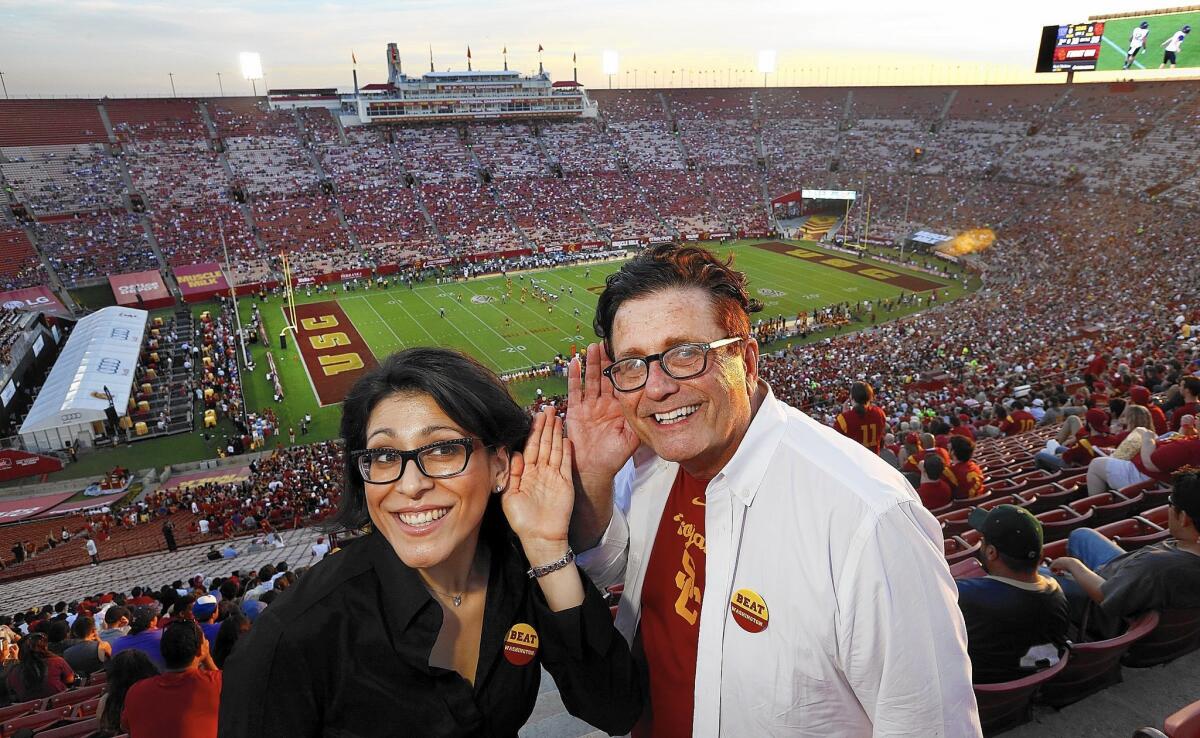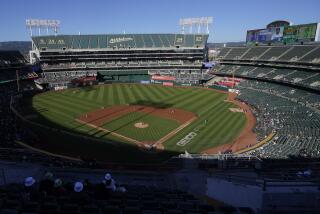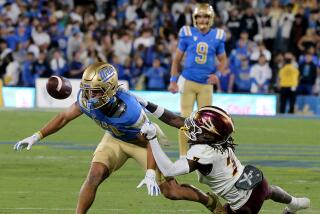Why is the Coliseum so quiet? Changes may be on the way

Early in the second quarter of the USC-Washington football game three weeks ago, Trojan fan Elizabeth Valmont began to apologize. Not for her team’s inability to convert third downs but for the Los Angeles Memorial Coliseum, so calm and quiet despite the best intentions of 63,623 fans.
“It’s all very civil,” she said in a rebuke to the venue.
Taking out her iPhone, the 35-year-old acoustical consultant opened an app that measures sound levels. It read 79.5 decibels, the equivalent of her phone’s dial tone.
In an era when football stadium noise has become a competitive frontier, USC has been dealt a bad hand. Acoustics in the Coliseum are lousy, and as a result, the Trojans do not enjoy the competitive advantage that many college and National Football League teams do in their home stadiums.
------------
FOR THE RECORD:
Coliseum acoustics: In the Oct. 29 Section A, an article about acoustics at the Los Angeles Memorial Coliseum misspelled the name of architectural firm Aecom as Aecon.
------------
Consider CenturyLink Field in Seattle, where screaming by Seahawks fans has created one of the most uncivil venues for football in America. Between its vertical walls of steel and concrete, its fans —popularly known as the 12th man — raise such a din that NFL opponents miss calls and lose time between plays.
We’re not as satisfied as we used to be with the simple experience of watching the spectacle of sport. Viewing a game needs to be more participatory.
— Christopher Mitchell, a project designer with Aecom
“We’re not as satisfied as we used to be with the simple experience of watching the spectacle of sport,” says Christopher Mitchell, a project designer with Aecom, which built CenturyLink Field. “Viewing a game needs to be more participatory.”
During one game at CenturyLink, the fan roar peaked at 136.6 decibels, a number that makes Valmont both determined and envious.
The Coliseum is too open, too exposed to hold on to sound, she said. The seating begins too far from the field, and the rake of the seats is too gradual. There is little to reflect the energy of sound waves back into the stadium.
“The architecture needs to support the fans,” Valmont said. It needs to reward them so that their cries, both the heckling and applause, can be heard not just from section to section but across the field itself.
Three years ago, the USC graduate made it a personal mission to change things for the louder. On a late-November day in 2012, she and Matt Wilkinson, a colleague at the Playa Vista office of the engineering and design firm Arup, visited the Coliseum for USC’s game against Notre Dame.
Working without a contract from USC, they sat among fans and recorded the sounds so they could analyze and determine what was wrong with the venue.
A year later, they presented the university with their solutions for the stadium’s acoustical deficiency, which hadn’t been high on USC’s agenda as it moved forward with a broad renovation of the Coliseum. In 2014, Arup officially became part of the USC design team, whose plans are expected to be disclosed at a Coliseum Commission meeting Thursday.
Valmont and Wilkinson proposed building a canopy over the stands on the north and the south side of the stadium that would reflect and hold in the noise.
They wanted a steeper configuration of some seating sections and construction of VIP boxes with glass facings that would reflect sound.
They also wanted more seats closer to the field and an overhaul of the existing sound system.
Each element, they argued, would ratchet up the volume, distracting and possibly confusing visiting teams and making the fan experience more exciting. It helped that their ideas also served other needs — such as VIP seating that would increase ticket revenue.
What they get depends on what the university can afford and whether the proposals will win the support of the Coliseum Commission and the city’s Cultural Heritage Commission, whose involvement is evidence that modernizing the Coliseum has never been an easy conversation.
Built on land owned by the state and administered by state, county and city officials, the stadium is tangled in bureaucracy and politics, and its designation as a National Historic Landmark has complicated the picture.
Completed in 1923, the Coliseum was praised as both a stadium and an amphitheater, and for two Olympics and even the first Super Bowl, its design — and the absence of premium seating or VIP boxes — has allowed for what Linda Dishman, president and chief executive of the Los Angeles Conservancy, calls a “very democratic” experience.
Over the years, the conservancy has been one of the stadium’s most consistent advocates, arguing for the preservation of the architecture and the original experience of visiting the Coliseum. But those impulses have often put the organization at odds with potential tenants, particularly representatives for owners in the National Football League.
The university understood the value of working closely with the conservancy, Dishman said.
“USC was more modest and less dogmatic in their proposals,” she said. “I think they like the Coliseum, whereas for the NFL, it was a venue to play football. They had no long-term associations with this resource.”
The agency has not yet taken a position on plans for the Coliseum, she said. Its board will review the proposals in November.
In USC design team meetings, the early proposals were scaled back for reasons that had more to do with budget and aesthetics than acoustics, university architect Jon Soffa said.
Some of the early schemes considered two new seating towers that would replace specific sections of the bowl. These towers — one of the north side of the stadium and one on the south — would have a new concourse and include suites, loge boxes and club seating.
These towers would allow for a steeper configuration of the seats and have canopies that overhung a portion of the stands.
Now only one of these towers is in the plans. It is on the south side with a new press box, and its canopy has been modified from earlier schemes in size, height and design based on input from the L.A. Conservancy and others. Soffa describes it as a “modest roof-deck shade screen” that also serves as an open-roof terrace.
Valmont understands why the changes were needed but is disappointed. Acoustics can complement history, she believes. She cites modern European architectural adaptations that blend new and old designs.
In the fourth quarter of the game against Washington, Valmont moved to a seat in the raucous student section.
The Huskies had the lead, 17 to 12. But the Trojans still had a chance and their fans knew it. When the Huskies got possession of the ball, the crowd went crazy.
“Make some noise,” flashed a message on the Jumbotron. “Get up on your feet.”
Cheerleaders raised placards. “Noise,” they encouraged.
The fans raised their voices in the loudest noise of the evening. It pressed against the eardrums until they almost started to ring.
Almost.
Valmont was happy. It showed the fans had the voices for it.
“This is excellent,” Valmont said above the roar.
Now if only the Coliseum itself can be made to cooperate.
Twitter: @tcurwen
ALSO:
Animal-welfare advocates push to help the poor keep their pets
These water districts are way short of their conservation targets
Shoemaker, 71, wants to move out of his van, but even a waiting list is out of reach
More to Read
Start your day right
Sign up for Essential California for news, features and recommendations from the L.A. Times and beyond in your inbox six days a week.
You may occasionally receive promotional content from the Los Angeles Times.







